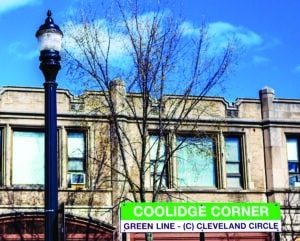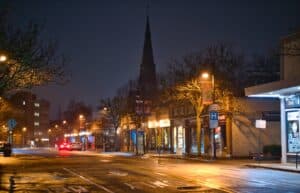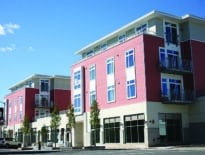
Brookline officials want to add housing on top of largely single-story commercial buildings that line the town’s main retail corridor. iStock photo
There’s broad agreement in Brookline that its main commercial corridor, with rows of independent shops and restaurants and walkable streetscape, is one of the town’s greatest assets.
But the Harvard Street corridor’s future is at stake as Brookline considers how to comply with the state’s MBTA Communities housing law, with sides lining up to debate rezoning the area. As an MBTA community with rapid transit service, Brookline is required to rezone for potential development of nearly 7,000 multifamily housing units by the end of the year along with fellow wealthy suburbs Newton and Milton.
To meet the deadline and help the state tackle its housing crisis, local officials plan to ask residents to OK more units along Harvard Street.
“Brookline is really the big wild card,” said Jesse Kanson-Benanav, executive director of pro-housing production group Abundant Housing MA. “Our folks are on the ground and making sure residents understand the stakes.”
In contrast to similar communities with city councils, the political path to compliance is winding in Brookline, the state’s most populous community with a town meeting form of government.
A pair of housing groups on either side of the Brookline Planning Department’s current proposal are issuing questionnaires and preparing to endorse candidates in the May 2 town election, as voters elect Brookline Town Meeting’s 255 members who will decide the issue.
Housing for Commercial Corridor
The MBTA Communities law is shaping up as the biggest challenge to Massachusetts communities’ land-use autonomy since Chapter 40B, the 1969 law that enables projects with at least 20 percent income-restricted units to be built in areas where they otherwise would be prohibited by local zoning.
The new law encourages dense, multifamily development near MBTA service in 175 cities and towns. MBTA communities are required to rezone at least one district of reasonable size within a half-mile of transit for at least 15 housing units per acre.
Town planners settled on a section of Harvard Street’s commercial corridor – stretching from Brookline Village north to the Allston line – for the proposed higher-density zoning district.

Rezoning of Brookline’s Harvard Street to comply with the MBTA Communities Act would encourage development of multifamily housing between Brookline Village and the Allston line. Photo by Chris Rycroft | Flickr/CC BY 2.0
In keeping with the state law, it relieves developers of the requirement of obtaining special permits for multifamily projects. The current zoning requires a special permit review for projects with 17 or more housing units.
The special permit requirement is so onerous that developers rarely propose housing except under Chapter 40B, said Jeff Wachter, a spokesman for the Brookline For Everyone group that supports the rezoning.
Housing is virtually impossible to build on Harvard Street under existing zoning regulations for maximum heights and floor area ratio, according to a memorandum issued in January by Town Administrator Charles Carey. The rezoning eliminates maximum FAR, or buildings’ maximum floor area on a lot.
Displacing a 15-Minute Neighborhood?
Housing activists attribute Greater Boston’s high housing prices partly on suburban communities’ zoning that discourages multifamily projects and stifles new supply. Despite its lofty housing prices – a median $2.4 million for single-family homes in 2022, according to Warren Group data – North Brookline retains pockets of transit-oriented density dating back to its streetcar suburb growth era of the 19th century.
Linda Pehlke, founder of the Brookline by Design group, said the Harvard Street corridor embodies the urbanist planning concept of making housing, workplaces and shopping accessible without automobiles.
“We’re the poster child for the 15-minute neighborhood,” said Pehlke, who opposes the potential rezoning. “We’ve got what everyone else wants, and they’re trying to make other places like Brookline. So, we’re scratching our head about the [MBTA Communities] rules.”
Pehlke founded the Brookline by Design group in 2019 to push for a comprehensive citywide planning process, updating the zoning for the first time since 1965 to address development trends such as teardowns to replace single-family homes with duplexes.
Rezoning opponents say the proposal is rushed to meet the state’s Dec. 31 guideline and will bring unintended consequences. Pehlke predicts single-story storefronts occupied by independent shops and restaurants will be replaced with monolithic apartment and condominium buildings without ground-floor retail.
“On the face of it, it just seems absurd. Our local businesses are still reeling from the pandemic, and it’s one of the most precious things in Brookline,” she said.

Steve Adams
Supporters acknowledge that state regulations prevent communities from requiring ground-floor retail in the new housing districts. But they are free to encourage commercial uses through separate incentives being considered as part of an ongoing planning study.
And owners of single-story retail buildings already face pressure to cover taxes and expenses without complementary uses, according to the memorandum supporting the Planning Department’s proposal.
Town officials are preparing to hire a form-based zoning consultant to bring a final proposal to the Brookline Select Board this spring, and ultimately to Town Meeting by year’s end.
In the meantime, both sides are focusing on the election of town meeting members sympathetic to their case.
“There’s a lot of frightening rhetoric around, so we’re educating people that it’s going to take years and change will happen gradually,” Wachter said. “No one is going in with a wrecking ball to tear down three blocks of Coolidge Corner.”





